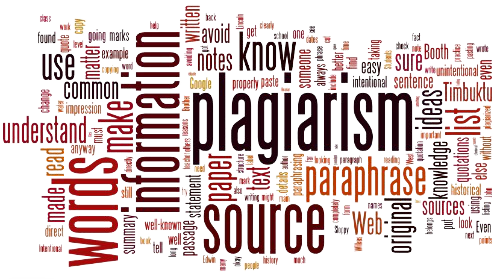plagiarism /’plaj??riz?m/1
Noun
The practice of taking someone else’s work or ideas
and passing them off as one’s own.
Synonyms
piracy / theft / fraud
Antonyms
original
There are two kinds of plagiarism: intentional and unintentional ~
1. Intentional plagiarism would be handing in a paper that someone else had written and claiming we wrote it ourselves. Even if the other person had given us permission to do it (for example, if it was a friend of ours who was trying to help us out) it would still be unethical and it would be plagiarism.
Intentional plagiarism would also include copying paragraphs or even sentences from a book or from an online article.
The consequences for intentional plagiarism can be very severe: anything from a failing grade on the assignment to dismissal from a school. No kidding!
Avoiding intentional plagiarism is pretty easy. We all know that we can’t just cut and paste information we find on the Web into our reports, and change the font so it matches the rest of the text. That much we all know. (And if you didn’t know that, please see me after class.)
2. Unintentional plagiarism, on the other hand, is not as clear. We know the general rule that when we use someone else’s ideas or words or images, we have to give credit to the source. But anybody who has written a paper or report will tell you that it’s not always so easy to tell what’s plagiarism and what’s not. And that’s where we have the problem. Even when we want to avoid plagiarism, we may find ourselves up to our eyeballs in plagiarized material.
In this lesson we are going to talk about a couple of the finer points of avoiding plagiarism, and we are going to practice correct paraphrasing so that we can do better in the future. We are not going to become experts in one class, but we should understand the rules of plagiarism better than we did before.
What we should already know…
…We all know (or should know) that even if we put information we have found into our own words, we still have to list the source. Ask yourself, “Would I know this if I hadn’t read it on that website or in that book?” If the answer is no, list the source. But…
Exception ~
…We don’t have to list the source of information that is a matter of common knowledge or that can be found in many reference sources — even if we personally did not know it before. That is because such knowledge is considered to be in the public domain.
Example ~
“Abraham Lincoln was the 16th president of the United States and he was assassinated on April 15, 1865 by John Wilkes Booth” is a well-known historical fact and you do not have to list a source if you make that statement.
But….
“Lincoln’s killer had a brother named Edwin Booth who was a well-known Shakespearean actor” is not such a well-known historical fact, and if I make that statement in a paper, I’d better say where I got the information. (By the way, I got it from, Good Brother, Bad Brother: The Story of Edwin Booth & John Wilkes Booth by James Cross Giblin. You can check it out at the middle school/high school library.)
Another example ~
“The chemical composition of water is H2O” is a matter of common knowledge, and I would not have to list a source if I made that statement in a paper.
But…
“Drinking too much water in a short period of time can cause a fatal medical condition known as Water Intoxication” is not a matter of common knowledge and if I use that information in a paper I need to list my source.
Bottom line ~
If the information we are using is a matter of common knowledge, we do not need to list the source. In all other cases, we must list our source. When in doubt, list the source anyway. You’re not likely to get in trouble for listing too many sources!
The ways we unintentionally plagiarize and how to avoid it…
Sloppy note taking ~
Sloppy note taking is one of the biggest reasons for unintentional plagiarism. Sloppy note taking is writing down information from a source without clearly labeling the information as either the work of others or our own words and ideas. Before we know it, we will have forgotten what information belongs to others and what belongs to us, but we go ahead and use it in our paper, anyway.
Well, we might not remember which words do not belong to us, but our teacher can easily find out. It’s as easy as doing a Google search of a suspicious phrase or using a Web service such as Turnitin.
The Purdue OWL (a highly reliable Web source for research and writing) suggests that when we are making our notes we mark other people’s words with a big Q or simply put quotation marks around them. They also recommend marking notes we made from sources with an S and notes of our own ideas with ME.
It really doesn’t matter how we label our notes, as long as we are careful to distinguish between our words and ideas and those that came from other sources, and are sure to clearly label any direct quotes.
Cutting and pasting information found on the Web is another common reason for unintentional plagiarism ~
And it is oh so easy to do! The ability to cut and paste information from the Internet has made plagiarism so common that we sometimes get the impression it is okay to use information on the Web anyway we like. But that impression is false. Not only is information on the Web copyrighted, but using it without listing the source is plagiarism, plain and simple.
Rather than cutting and pasting, we should make a habit of always paraphrasing our notes. The only thing that we should copy verbatim is a direct quote, and then we should be sure to use quotation marks or mark it with a large Q.
And, of course, we should immediately write down the source information in our notes directly next to the information so that we do not confuse things later.
Imitating the syntax or phrasing of a source ~
Students frequently change a few words in a text thinking that by doing so they are avoiding plagiarism. They are mistaken. Even if we change a few words here and there, but we retain the same arrangement of words in a sentence or mimic the sentence structure of the original, it is a form of plagiarism. To avoid plagiarism, a text must be completely restated in our own words and in our own style.
Understanding the difference between a summary, paraphrase, and quote ~
A summary is a concise statement of the main ideas of a passage written in your own words.
A paraphrase is more detailed than a summary. Whereas a summary contains only the main points of a passage, a paraphrase should include the details as well, but still in your own words.
A quote is a word for word copy of a phrase, sentence, or paragraph written by someone else. This must always be set off in quotations marks or blocked text with the name of the source directly next to it.
Tip: You should use direct quotations sparingly. Some reasons to use quotations would be to emphasize a point you’ve made, to provide an example of something you are discussing, to highlight a thought that is particularly well expressed by the author, or to demonstrate how historical figures spoke. But keep in mind that a paper consisting mostly of quotations is a form of plagiarism, even if all of the sources are properly listed.
Proper Paraphrasing ~
Students often fall into plagiarism because they do not understand how to correctly paraphrase. The solution is to 1) learn how to paraphrase properly and 2) make sure we put enough of our own thoughts in our paper so that it is not made up entirely of other people’s ideas.
The first requirement for proper paraphrasing is to make sure you understand what you have read completely. If you do not fully understand what you have read, it will be impossible to restate it in your own words. This means that you should try to read texts that are on your reading level whenever possible, and if you are required to read a text above your reading level, look up the definition of any words you do not understand and/or get help from your teacher or librarian.
Once you thoroughly understand what you have read, it is appropriate to write down important names and dates that you might have a hard time remembering. When you are ready to make your paraphrase, you should try to do it without looking at the original source in order to avoid copying the author’s words or sentence structure, but it is okay to use the names, dates and other numbers you wrote down. After you have made your paraphrase in your own words, look back at the original to make sure you did not leave out any important details.
Some Examples ~
Click on this presentation, Identifying Plagiarism, from ReadWriteThink to see several examples of rewritten passages of text. Can you tell which are properly paraphrased and which are plagiarized?
Your assignment ~
Make a copy of this worksheet and add your name in front of the word “Timbuktu” in the title. Read the paragraph until you have full understanding. Be sure to look up any unfamiliar words. (You can use the Research and Definition tools in Google Drive to do this.) Once you feel you understand the passage thoroughly, paraphrase it beneath the original. You should avoid looking at the original while you are doing your paraphrase. After you make your paraphrase, refer back to the original to check spellings and make sure you covered all of the details.
For most Americans, Timbuktu has long stood for, well, nowhere — a place far, far away, probably in fiction. But deep in the West African nation of Mali, where the savannah grasslands meet the Sahara, lies Timbuktu. It’s an impoverished town of about 30,000, most of them nomadic traders or subsistence farmers. But Timbuktu is rich in history — history that contradicts a commonly held impression in the West that sub-Saharan Africa has only oral and no written traditions. (Timbuktu)
I highly recommend that you watch the video on the PBS website because it will give you context for the passage–and context is always helpful!
Additional Resources ~
Paraphrase: Write it in Your Own Words from the Purdue Owl
If you need help with your assignment, stop into the library during study halls and before or after school. And don’t forget Library Chat, your 24/7 access to TKCS libraries!
The Tutorial Library has moved to the Middle School page of this website.

